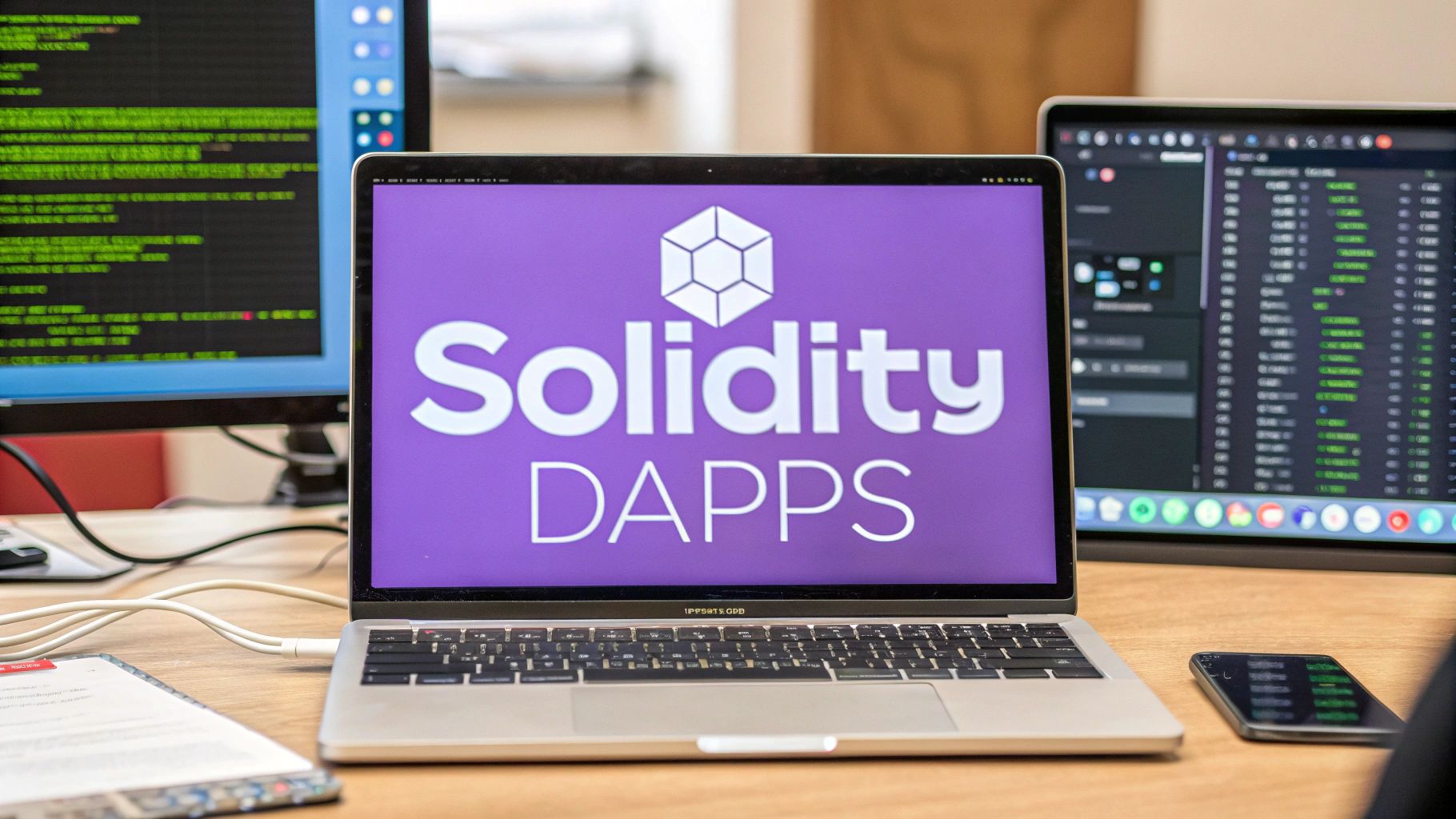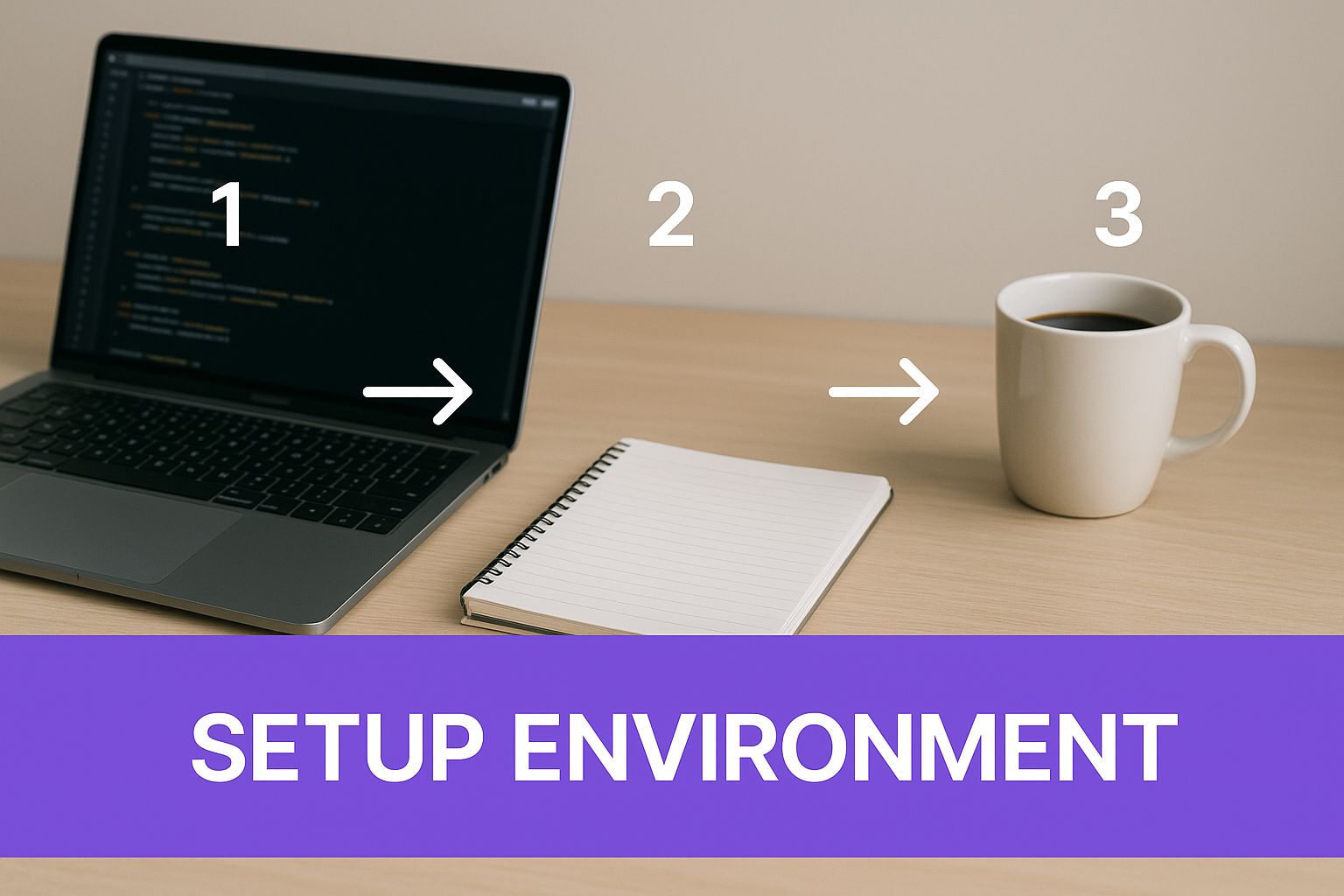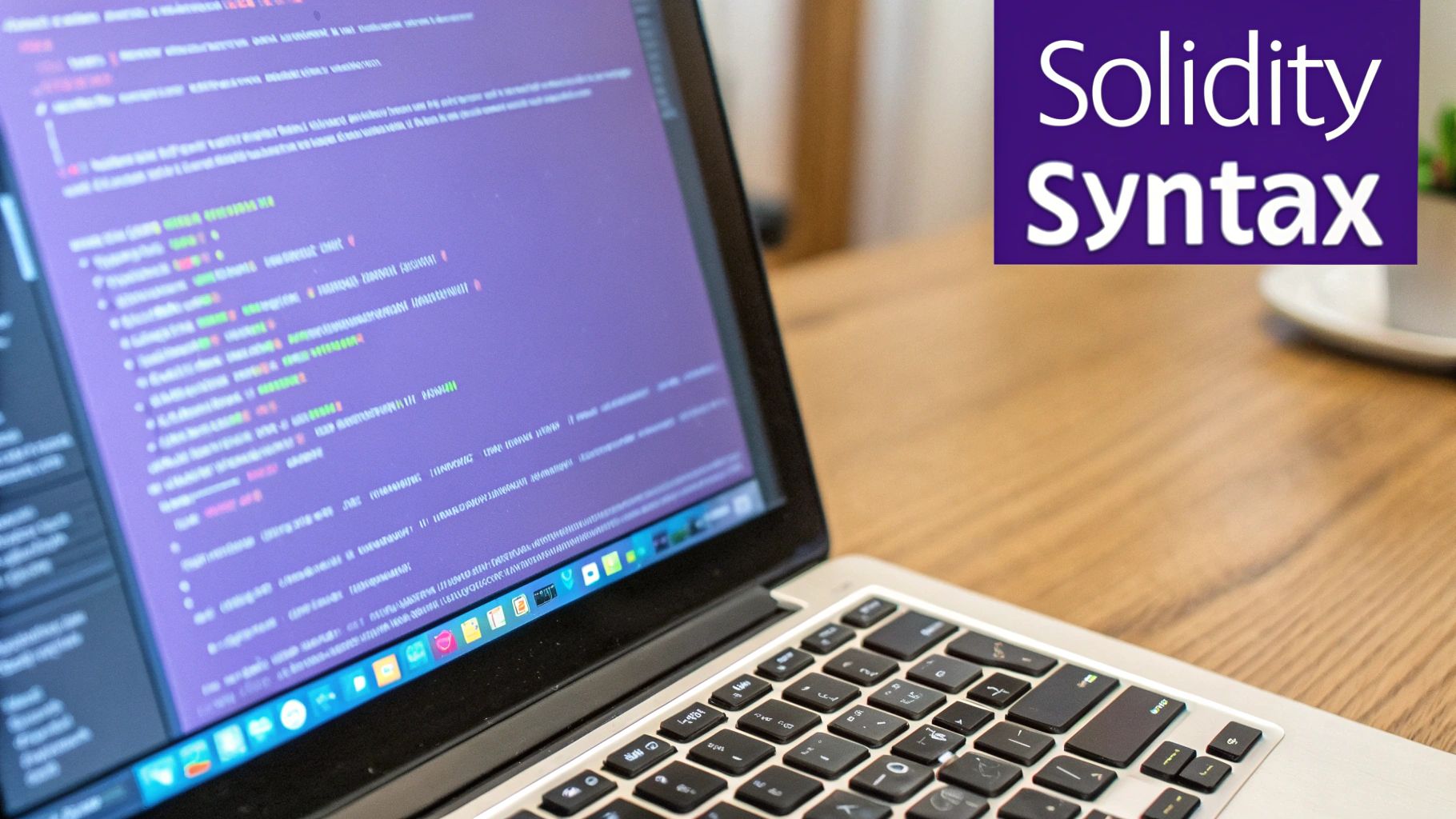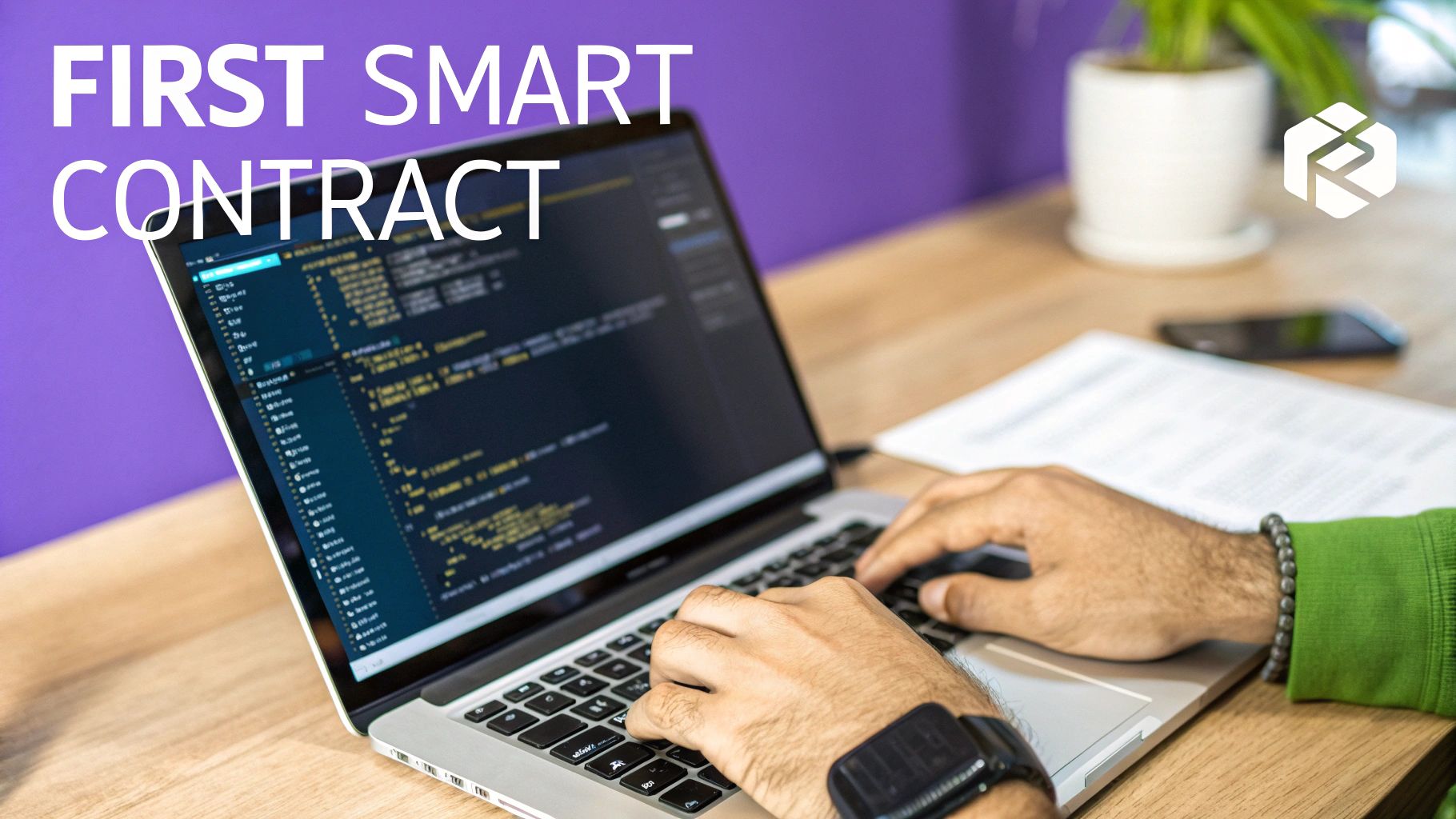Your Solidity Programming Tutorial to Build DApps

Before we jump into writing code, let’s get one thing straight: understanding why we use Solidity is just as important as knowing how. If you get the core philosophy behind it, you’ll write better, safer smart contracts from your very first line.
Why Solidity Is the Go-To for Smart Contracts
So, you want to build on the decentralized web? Great. You’re going to hear one name over and over again: Solidity. It’s the undisputed king for creating smart contracts—the self-executing code that makes the whole thing work.
It's not just popular for the sake of it. The language was intentionally designed to feel familiar, borrowing heavily from giants like C++ and JavaScript. This was a smart move, as it gives developers a much smoother on-ramp into the often-intimidating world of blockchain. You're not starting from scratch.
Built for the Ethereum Virtual Machine
At its heart, Solidity’s power comes from its deep connection to the Ethereum Virtual Machine (EVM). The EVM isn't just a piece of software; it's the global, decentralized computer that runs smart contracts on Ethereum and a growing number of other chains.
Solidity is the native tongue of the EVM. Code written in Solidity compiles down into bytecode that the EVM understands perfectly. This direct line from your code to execution is what makes it so efficient and secure. It’s why it’s the standard. You can find more about its critical role in the ecosystem on rapidinnovation.io.
A Laser Focus on Security and Precision
Let's be real: on the blockchain, mistakes are expensive. Transactions are almost always irreversible, and a tiny bug can mean a massive loss of funds. There are no do-overs. Solidity was built from the ground up for this high-stakes game.
It’s a statically-typed language, meaning you have to explicitly define what kind of data every variable holds—whether it’s a number, a wallet address, or a piece of text.
This might seem like a small detail, but it’s a lifesaver. It forces the compiler to catch a whole class of potential errors before you deploy, saving you from a world of hurt down the line.
This built-in strictness encourages you to be deliberate with your code. That’s exactly the mindset you need when you're building applications that handle real assets. For anyone looking to build that solid foundation, resources like the VTrader Academy are great for getting the bigger picture on blockchain fundamentals.
A Contract-Oriented Mindset
Solidity isn't a general-purpose language you’d use to build a website. It’s contract-oriented, which means its entire structure is designed to do one thing really well: create smart contracts. These are essentially bundles of code and data that live at a specific address on the blockchain.
This focus gives you specialized tools right out of the box:
- State Variables: Your contract's permanent memory, stored right on the blockchain.
- Functions: The actions your contract can perform, which can read or change its state.
- Events: A way for your contract to shout out to the outside world, letting front-end apps know when something important has happened.
This design makes the logic of decentralized systems feel much more natural to write. It’s this same set of core principles that platforms like Dreamspace—a vibe coding studio that works like an AI app generator—use to automatically craft secure and efficient smart contracts.
Configuring Your Solidity Development Environment
Getting your hands dirty with any serious solidity programming tutorial starts with a solid, clean setup. Trust me, getting your local environment right from the beginning saves you from a world of future headaches. It clears the path so you can focus on the fun part—actually building.
Most modern web and blockchain development is built on the back of Node.js. Think of it as the engine that lets you run JavaScript outside a browser and manage all your project's moving parts. Your first real step is getting this installed. Once you have it, you get its package manager, npm, which is the key to installing everything else you'll need.
This flow chart gives you a bird's-eye view of how a modern dev environment comes together.

It’s a clear roadmap, showing how each piece builds on the last. Following this path makes for a much smoother experience.
Firing Up A Hardhat Project
With Node.js in place, we can bring in the star of the show: Hardhat. This is the go-to development environment for pros—it’s what we’ll use to compile, test, and push our smart contracts live.
Getting started is surprisingly simple. Just make a new folder for your project, open your terminal there, and run npx hardhat. This single command launches an interactive guide that builds out a complete sample project for you.
You’ll immediately see a clean, organized structure:
- contracts/: Where your Solidity
.solsource files will live. - scripts/: For all your deployment and interaction scripts.
- test/: The home for your automated tests.
- hardhat.config.js: The control center for your entire project.
That
hardhat.config.jsfile? It’s the brain of the whole operation. This is where you’ll tell Hardhat which Solidity version to use, connect to networks like a local test node or a public testnet, and add powerful plugins.
The Zero-Setup Path
Look, setting up a local environment is a classic rite of passage, but sometimes you just want to build. Right now. This is where AI-powered tools are completely changing the game.
An AI app generator like Dreamspace, which is essentially a vibe coding studio, automates this entire setup.
Instead of wrestling with installations and config files, you just describe the smart contract you want. Dreamspace spins up the entire environment for you. It’s a lot like the experience you get with the best low-code development platforms. It lets you skip the tedious parts and dive straight into the logic of your DApp, radically shortening the distance from idea to deployment.
Alright, theory is one thing, but getting your hands dirty is where the magic really happens. Let’s jump past the abstract stuff and build a practical, decentralized voting system. This is a real-world project you can really sink your teeth into.
We're going to build this smart contract from the ground up, and I’ll break down every single line of code. It's not just about knowing what to type, but why. By the end, you'll have a working DApp that truly cements your grasp of core Solidity concepts.

Laying the Foundation with State Variables
Every smart contract needs a way to store data on the blockchain, and for that, we use state variables. For our voting system, there are a few key pieces of information we absolutely need to track.
First, we need to know who has the authority to create the vote in the first place. An address variable is perfect for storing the wallet address of the contract's owner. Next, we have to manage the candidates and their vote counts. A simple list won't cut it here; we need something more efficient for lookups.
This is where mappings come into play. Think of a mapping as a super-charged dictionary or hash map. It’s ideal for linking one piece of data to another, like a candidate's ID to their entire profile.
Structuring Our Data for Clarity
While mappings are fantastic for quick lookups, sometimes you need to bundle related data together. For our candidates, we don't just want a name; we need their unique ID, their name, and their current vote tally.
Solidity’s struct is the perfect tool for the job.
A struct lets you define your own custom data type. We’ll create a Candidate struct that neatly packages these three bits of information into a clean, single object. This keeps our code way more organized and much easier to read down the line.
Here’s a quick look at the core data elements we'll be using:
address public owner;: This will store the wallet address of the person who deployed the contract.struct Candidate { ... }: This acts as a blueprint for our candidate data, holding an ID, name, and vote count.mapping(uint => Candidate) public candidates;: A mapping to look up aCandidatestruct using their unique ID.mapping(address => bool) public voters;: This is a simple but crucial mapping to track which addresses have already voted, preventing anyone from voting twice.
The real power here is in how these elements combine to create a robust data model. A well-thought-out data structure from the start makes writing the actual contract logic much simpler and less error-prone. Good data architecture is the bedrock of a secure and reliable smart contract.
Before we dive into functions, it's helpful to have a quick reference for the data types you'll encounter most often.
Core Solidity Data Types and Their Practical Uses
This table is a quick reference guide to common Solidity data types and when you might use them in your own smart contracts.
Having a solid grasp of these types is fundamental. They are the building blocks for almost everything you'll do in Solidity.
Bringing the Contract to Life with Functions
With our data structures in place, it’s time to create functions to actually interact with them. Functions are the "verbs" of our smart contract—they define the actions it can perform. For our voting DApp, we’ll need functions to add candidates, let users cast their votes, and pull the final results.
Each function needs a specific visibility, which dictates who is allowed to call it. For instance, our vote() function will be public so anyone can participate. But the function to add a new candidate? That should be restricted to the contract owner. We can enforce this "owner-only" rule cleanly with a modifier—a reusable piece of code that checks conditions before a function runs.
This is a fascinating field, and for those curious about what lies beyond smart contracts, our guide on building generative AI-powered apps offers a wider view of modern development.
Building DApps like this voting system from the ground up is an incredible learning experience. It’s also worth noting that a vibe coding studio like Dreamspace can act as an AI app generator, taking your high-level requirements and scaffolding the entire contract—including structs, mappings, and functions—in just moments.
Mastering Smart Contract Testing And Debugging

In the world of smart contracts, there are no take-backs. No "undo" button. Once your code is on-chain, it's there forever—bugs and all. This isn't just a suggestion; it's the law of the land. A tiny slip-up can explode into a massive, irreversible failure.
This is why a security-first mindset isn't just a good idea, it's the only way to build. Every function, every single condition, every possible way a user could interact with your contract—it all has to be battle-tested before it even sniffs a live network.
Thankfully, you don't have to go it alone. Modern frameworks like Hardhat make this whole process not just bearable, but actually pretty slick.
Crafting Your Test Scripts
Hardhat plays incredibly well with testing libraries like Chai. It's an assertion library that lets you write your tests in a way that feels almost like plain English. You'll set up your test files inside the test/ directory, writing scripts that act like real users poking and prodding your contract.
Your mission is to build a full suite of tests that cover every possible angle. Think of it this way:
- The Happy Path: Does the contract do what it’s supposed to when everyone plays nice? Can a voter actually cast their vote without a hitch?
- The Edge Cases: What happens when things get weird? Can someone vote if there are zero candidates? What if a million votes are cast at once?
- The Revert Conditions: This is crucial. Does your contract correctly shut down bad actors? It must stop a non-owner from adding candidates or prevent a user from voting twice.
By hammering your code with these scenarios, you're building a digital safety net. Each passing test is another layer of confidence, proving your logic is solid.
The Power Of Local Debugging
Even with the best tests, bugs will happen. You'll hit a point where you just need to see what the hell is going on inside the contract as it runs. This is where Hardhat's console.log support becomes your secret weapon.
Unlike on mainnet, the local Hardhat Network lets you drop console.log statements right into your Solidity code. When you run your tests, these logs spit out directly to your terminal. You get a live feed of state variables, function inputs, and calculations.
This simple trick is a game-changer. Being able to see values mid-execution cuts down your debugging time from hours to minutes. No more guesswork—you can pinpoint the exact line where things went wrong.
This is the kind of deep, rigorous testing that separates the pros from the tourists, and it’s a core part of any serious solidity programming tutorial.
While you should get your hands dirty with manual testing, it's also smart to use tools that give you a head start. A vibe coding studio like Dreamspace can generate contracts that are already wired with security best practices from the jump. As an AI app generator, it builds a secure foundation, letting you focus on the creative logic while it handles the security grunt work.
This blend of hands-on testing and AI assistance is the new workflow for building DApps you can actually trust.
Alright, you’ve built your smart contract and put it through its paces locally. Now for the fun part—letting it see the world. It’s time to deploy your work to a live testnet.
This is the final dress rehearsal before you go to mainnet. It’s where you see how your code really behaves in a live, decentralized environment. It's the moment of truth.
Taking your contract from your local machine to a public blockchain like Sepolia (a popular Ethereum testnet) is a huge step. Getting this right is a core skill for any serious developer.
Getting Connected
First, you need a way for your local Hardhat setup to talk to the public blockchain. This is where an RPC (Remote Procedure Call) provider comes into play. Think of services like Infura or Alchemy as your bridge to the network. They give you a URL that connects your deployment script straight to the testnet.
You’ll also need a wallet with a little bit of test Ether to cover the gas fees for deployment. Don't worry, it's not real money. You can get free Sepolia ETH from a faucet. Just drop in your wallet address, and they’ll send you enough to get your contract deployed.
This is where you graduate from a hobbyist to a pro. Mastering the entire lifecycle—from writing the first line of code to getting it on-chain—is what makes you truly valuable.
The need for developers who can confidently ship code has exploded. We’ve seen a 300-500% annual increase in demand for Solidity devs since 2018, thanks to the boom in DeFi, GameFi, and NFTs. This is a skill set that commands serious attention. You can read more about these Solidity hiring trends and what startups need to know.
Verifying on Etherscan and Going Live
Once your deployment script runs, your contract will have a permanent address on the testnet. The last, crucial step is to verify it on a block explorer like Etherscan. This basically just means uploading your source code and linking it to your contract's on-chain address.
Why bother? A few big reasons:
- Transparency: Anyone can read your Solidity code and see what it does. No secrets.
- Interaction: Etherscan creates a simple UI so you (and others) can call your contract's functions directly from their site.
- Trust: It's public proof that the code running on the blockchain is the exact same human-readable code you wrote.
For more complex DApps with multiple contracts and tricky setups, this can get complicated fast. A vibe coding studio like Dreamspace helps cut through that noise. As an AI app generator, Dreamspace can automate deployment scripts and configs, clearing the path from a tested contract to a live DApp people can actually use.
Answering Your Burning Solidity Questions
As you start getting your hands dirty with Solidity, you're bound to run into the same questions that trip up most developers. Let's tackle some of the most common ones I hear all the time.
Remix vs. Hardhat vs. Truffle: What's the Real Difference?
Think of it this way: Remix is your quick-and-dirty scratchpad. It's a browser-based IDE, which means no setup is required. It's perfect when you just want to test a quick idea or a small function without spinning up a whole local environment.
When you're ready to build a real, production-grade application, you'll graduate to a proper development framework like Hardhat or Truffle. These are the pro tools.
Hardhat has become a favorite for many, especially because of its fantastic debugging support (hello, console.log in your contracts!), great TypeScript integration, and overall flexibility. Truffle is the seasoned veteran, an older framework with a massive ecosystem of plugins and a long track record. For any serious project, your team will almost certainly be using one of these two for their powerful testing and deployment automation.
How Do I Stop Wasting Money on Gas Fees?
Gas optimization is less of a feature and more of a fundamental skill for any serious Solidity developer. Every single operation on the blockchain costs money, so writing lean code isn't just a good practice—it's essential.
Here are a few core strategies I always come back to:
- Be smart with data types. Don't use a
uint256if auint128will do the job. - Keep storage writes to a minimum. They are incredibly expensive. Do your calculations in memory whenever possible, and only write the final result to storage.
- Use events. Instead of storing tons of data on-chain, emit events. Your DApp front-end can listen for these and display the information without cluttering up your contract's state.
- Write clean loops and cut out any function calls that aren't absolutely necessary.
This isn't just about small tweaks. It’s about adopting established patterns. A deep dive into over 23,000 smart contracts revealed that a staggering 99% rely on specific "micro-patterns" for both security and gas savings. You can dig into the full research on these Solidity micro-patterns and their usage.
What Security Holes Should I Actually Worry About?
The big ones that keep developers up at night are Reentrancy attacks, Integer Overflow/Underflow, and unchecked external calls. To guard against these, you need to bake security into your process. Always use the Checks-Effects-Interactions pattern, take advantage of the built-in overflow protection in Solidity 0.8.0+, and never, ever trust data coming from an external contract without validating it first.
A formal security audit isn't optional for any DApp that handles real value. It’s your last line of defense against a potentially project-ending exploit. Treat it as a non-negotiable step.
Speaking of smart development, if you're exploring how modern tools can speed up your entire workflow, you might find our look at an AI website builder vs WordPress interesting. It covers similar ideas about efficiency and choosing the right tool for the job.
Ready to stop just learning and start shipping? With Dreamspace, you can use AI to generate an entire on-chain application. Skip the boilerplate and focus on building what matters. Generate your smart contracts, data APIs, and a complete DApp front-end at https://dreamspace.xyz.